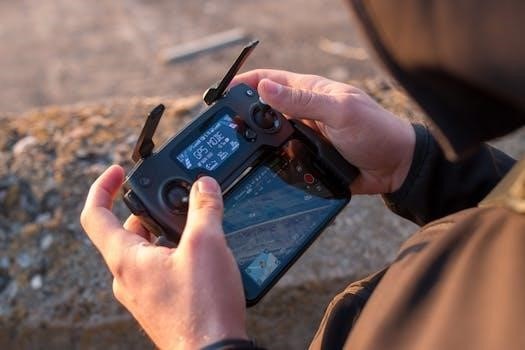
Hayman Reese Brake Controller User Manual Overview
This manual provides comprehensive instructions for Hayman Reese brake controllers, covering installation, operation, and maintenance. It details features like manual override, sync control, and LED indicators. Guidance is offered for adjusting braking force and interpreting self-diagnostics.
Hayman Reese brake controllers are essential devices that enhance the safety and efficiency of towing vehicles by managing trailer braking systems. These controllers assist in synchronizing the braking of the trailer with the towing vehicle, preventing sway and ensuring smooth stops. Designed to suit various towing needs, from light to heavy-duty applications, Hayman Reese offers both proportional and time-activated models. Proportional controllers automatically adjust trailer braking force based on the towing vehicle’s deceleration, while time-activated controllers apply brakes at a set rate. The units feature user-friendly interfaces for easy adjustments and incorporate manual override functions for added control. These controllers are engineered for simple installation with plug-and-play options, making them compatible with the SmartClick harness system. Hayman Reese brake controllers aim to offer a seamless and reliable towing experience.
Types of Hayman Reese Brake Controllers⁚ Proportional and Time-Activated
Hayman Reese offers two primary types of brake controllers⁚ proportional and time-activated. Proportional brake controllers, such as the CompactIQ Proportional model, sense the towing vehicle’s deceleration rate and apply the trailer brakes proportionally. This ensures a smoother and more responsive braking experience, as the trailer’s braking force matches the vehicle’s. These controllers are ideal for varying road conditions and are particularly useful for heavier loads. Time-activated controllers, like the Sentinel model, apply the trailer brakes at a predetermined rate, regardless of the towing vehicle’s deceleration. These controllers use solid-state electronics to provide consistent braking force over time. While simpler in design, time-activated controllers are well-suited for light to medium-duty towing applications. Choosing the right type depends on your specific towing needs and preferences; proportional controllers often provide more refined control, while time-activated options offer a cost-effective solution for simpler needs.

Installation of Hayman Reese Brake Controllers
Installation involves mounting the unit, making correct wiring connections for power, brake signals, and trailer wiring. Hayman Reese offers Plug & Play options with SmartClick harness compatibility for easier setup.
Mounting the Brake Controller Unit
The Hayman Reese brake controller main unit is designed for discreet mounting within the vehicle’s cabin. Consider locating it in a position that allows for easy access to the manual override button and visibility of the LED indicator. The controller can be mounted using screws, typically in a spare switch panel or under the dashboard. Ensure the chosen location doesn’t interfere with the driver’s movements or other vehicle controls. The remote function dial for some models can be mounted separately, providing flexibility in dashboard layouts. When choosing a spot, it’s important to ensure the unit is secure and won’t move during vehicle operation. Check for sufficient space around the unit for wiring and proper ventilation. Always refer to the specific product instructions for the correct mounting procedures and recommended locations for your particular Hayman Reese model, as it may vary based on the unit’s design. Proper mounting is essential to achieve safety and optimal performance.
Wiring Connections⁚ Power, Brake Signal, and Trailer Wiring
Connecting your Hayman Reese brake controller involves wiring for power, the brake signal, and the trailer brake output. Power is typically sourced from the vehicle’s battery, often through a fuse to protect the system. The brake signal wire connects to the vehicle’s brake light switch, usually found near the brake pedal. The trailer brake output wire runs to the trailer plug, activating the trailer brakes when the vehicle brakes are applied. A complete wiring harness, purchased separately if not already present, might be required. It’s crucial to ensure the correct wiring connections to avoid damage to the vehicle or the controller. Some models feature a plug-and-play system using the Hayman Reese SmartClick harness, simplifying the process. Always double-check your connections against the specific wiring diagram included with your controller. Correctly routing the wires, potentially through a grommet hole, is important to ensure they are safe from wear and tear.
Plug & Play Feature and SmartClick Harness Compatibility
Hayman Reese brake controllers often feature a convenient plug-and-play design, which streamlines the installation process. This feature allows for a quick and easy connection, significantly reducing the time and effort needed to set up the controller. The plug-and-play functionality is primarily achieved through the compatibility with the Hayman Reese SmartClick brake control harness. This harness is designed to directly connect to the vehicle’s existing wiring, often using a dedicated factory plug if available. This eliminates the need for extensive wire splicing and ensures a more secure and reliable connection. The SmartClick harness is a key component for utilizing the plug-and-play feature, offering a simplified installation for users who prefer a less complex setup. This feature is particularly beneficial for those who may not have extensive electrical wiring experience or who simply prefer a faster installation. However, it’s vital to confirm that your vehicle is compatible with the SmartClick harness for the controller you are installing.

Operation and Features
Hayman Reese brake controllers offer adjustable braking force, sync control, and a manual override button. LED indicators provide operational status. These features ensure optimal control and safety while towing various trailers.
Adjusting Braking Force and Sync Control
Hayman Reese brake controllers allow users to precisely adjust the braking force applied to the trailer, ensuring a balanced and controlled stop. This adjustment is crucial for maintaining stability and preventing trailer sway, particularly in varying load conditions and terrains. The braking force can be tailored to match the towing vehicle’s deceleration, enhancing overall braking efficiency and safety. Sync control is another vital feature, allowing the trailer brakes to activate in harmony with the vehicle’s brakes, creating a seamless braking experience. Proper synchronization prevents jerky stops and reduces strain on both the towing vehicle and the trailer. The controller’s interface, often featuring a rotary knob or digital display, facilitates easy adjustments and real-time monitoring of the braking parameters. Achieving the optimal braking force and synchronization requires careful calibration, which is essential for safe towing practices and a smooth, controlled ride, whether on or off-road. This ensures the trailer brakes respond proportionally to the vehicle’s braking efforts.
Manual Override Button Functionality
The manual override button on a Hayman Reese brake controller provides a critical safety feature, allowing the driver to independently activate the trailer brakes. This functionality is paramount in situations requiring immediate and controlled braking of the trailer, such as during emergency maneuvers or when experiencing trailer sway. Unlike normal braking which relies on the vehicle’s brake pedal, the manual override directly engages the trailer’s electric brakes, giving the driver full command over the trailer’s deceleration. This independent control can assist in stabilizing the trailer and preventing potentially hazardous situations. The override button is typically located on the controller unit for easy access, allowing the driver to quickly apply the trailer brakes without delay. The manual override does not require the vehicle’s braking system to be active; it is a separate, dedicated means of controlling the trailer’s braking response. It is important to understand and practice the use of the override button in a controlled environment to become proficient in its operation. In addition, it can be used for testing brake operation in a controlled environment.
LED Indicator Interpretation
The LED indicator on Hayman Reese brake controllers serves as a crucial visual communication tool, providing real-time feedback on the system’s operational status. Different colors and patterns displayed by the LED typically signify various conditions of the brake controller. For instance, a solid green light might indicate normal operation and that the controller is properly connected and functioning. A flashing light, or a light of a different color such as red, could signal an issue, such as a fault in the wiring, a problem with the trailer brakes, or perhaps an overload or short circuit. Some models might utilize varying intensities or blinking speeds to further differentiate the type and severity of the issue. It is essential to consult your specific model’s user manual to correctly understand the meaning of each pattern and color sequence. The LED indicator allows for quick identification of potential issues, enabling timely corrective actions and ensuring safe and reliable towing. Proper understanding of the LED indicator is crucial for maintaining the brake controller and trailer braking system in optimal condition.

Troubleshooting and Support
This section addresses common issues, self-diagnostic functions, warranty information, and customer service contact details. It aims to assist users in resolving problems and ensuring optimal performance.
Self-Diagnostic Function and Common Issues
Hayman Reese brake controllers incorporate a self-diagnostic function to aid in identifying potential problems. This system can detect issues with wiring, power supply, or internal components, often indicated by specific LED patterns or error codes. Common issues may include a lack of power to the controller, incorrect wiring connections, or a malfunctioning brake signal from the towing vehicle. The controller might not activate the trailer brakes, or it might apply them inconsistently. If the LED indicator is not illuminating as expected, it can suggest a power issue, or a fault with the wiring harness. Users should verify all connections are secure, and consult the manual for specific error codes. Also, check the trailer’s brake wiring for any shorts or issues. This diagnostic feature helps pinpoint the issue before seeking professional assistance. Always refer to the user manual for specific diagnostic interpretations.
Warranty Information and Customer Service Contact
Hayman Reese brake controllers are typically backed by a manufacturer’s warranty, designed to cover defects in materials and workmanship. The specific warranty period may vary, so it is crucial to check the documentation included with your purchase or the Hayman Reese website for details. If you experience any problems during the warranty period, contacting customer service is essential. They can guide you through troubleshooting steps and advise on warranty claims. For customer service, you can usually find contact details, including phone numbers and email addresses, on the Hayman Reese website. They provide support for installation questions, operational problems, and warranty-related inquiries. Additionally, you can consult the website for a list of authorized service centers; Ensure you have your purchase details ready when contacting customer support. Remember that unauthorized repairs might void your warranty. Always follow the guidelines provided by Hayman Reese to ensure smooth service.